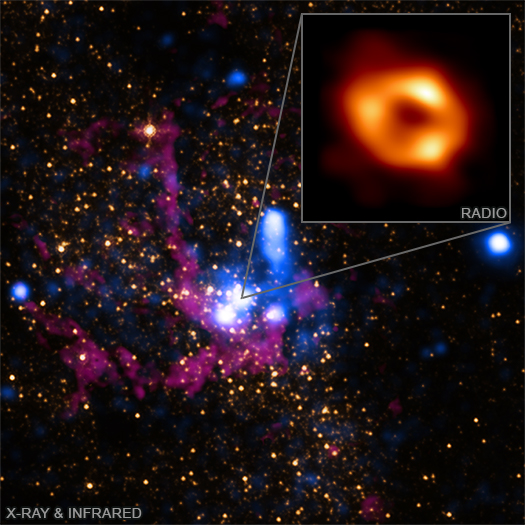Looking at the Team Behind the Science

Sagittarius A*: The Black Hole at the Center of the Milky Way Galaxy
Credit: X-ray: NASA/CXC/SAO; IR: NASA/HST/STScI. Inset: Radio (EHT Collaboration)
Many projects in astrophysics involve huge numbers of scientists and other collaborators — often ranging from senior professors to graduate students and undergraduates. A project like the EHT often requires smaller groups within these large collaborations to concentrate on different problems and questions.
The latest result about the Milky Way's central black using many different telescopes in concert with the Event Horizon Telescope (EHT) is an excellent example of such a successful web of groups working together with others in the project to make the sum even greater than its parts.
To learn more about the group behind the "multiwavelength" (MWL) observations that included Chandra and other telescopes, we asked Sera Markoff and Daryl Haggard, two of the coordinators of the EHT's MWL Working Group, a series of questions.
Sera Markoff is a Professor of Theoretical High Energy Astrophysics at the University of Amsterdam and a member of the EHT project and vice-chair of its science council. Professor Markoff is a graduate of the Massachusetts Institute of Technology and the University of Arizona, where she earned her Ph.D. You can learn more about her and her group based in Amsterdam at https://www.seramarkoff.com/
Daryl Haggard is an Associate Professor at McGill University in Montreal. Her research interests include studying the Galactic Center and the supermassive black hole that resides there as well as electromagnetic counterparts to gravitational wave sources and more. She is a graduate of St. Johns College in New Mexico, San Francisco State University, and received her Ph.D. from the University of Washington. Like Sera Markoff, she leads a group of early career scientists: https://www.dhaggard.physics.mcgill.ca/research-group
Chandra Blog: Please outline the main goal of your EHT team.
Sera Markoff: To support the scientific interpretation of EHT images by providing complementary information from observations at other wavelengths.
Daryl Haggard: To look at the broader environment (at larger spatial scales and multiple wavelengths) to better understand the EHT's horizon-scale targets, and also to connect these systems to SMBH observed across the Universe.
Chandra: Can you describe how your team came together? Was it because of the EHT project or were some people already working together before?
Markoff: Many of us worked together before because it's not a huge community, but our Working Group was formed in particular because of the EHT project.
Haggard: Lots of us come to the EHT collaboration with a particular target or set of targets that we have studied before, but the EHT binds us together and helps us organize our massive, international observational efforts aimed at understanding black holes.
Chandra: How does your team operate with people at different institutions and in different locations?
Markoff: This has been a really big challenge in a global collaboration. We do most of our work remotely, which was the case even before the pandemic. We try to hold regular telecons at a time zone that works from Hawaii to Japan to Europe. In practice, usually this ends up very early morning or very late night for East Asia. During the pandemic we needed to have some concentrated work periods called "busy weeks." We developed a staggered time zone approach where teams worked in grouped time zones and then handed over the "baton" to the next time zone, combined with daily plenaries with everyone together. This was exhausting but did seem to work.
Haggard: The multi-wavelength science working group has three co-coordinators, currently in Europe (Sera Markoff), Asia (Kazuhiro Hada) and North America (Daryl Haggard). With these three anchor points, we bring together scientists from all over the world, e.g., a recent MWL study we did for M87* involved 19 observatories (on the ground and in space), 760 scientists and engineers, and 200 different institutions. This is a colossal effort (and yes, a zillion Zoom calls), but it's also super fun and exciting. We're all so lucky to come together to share knowledge and expertise, and to study black holes (seriously cool).


